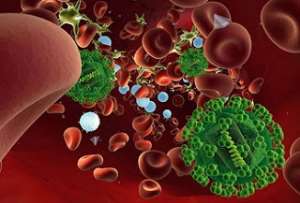
HIV-Aids virus: Diseases are deliberately and easily spread in many ways, for example, through food, water, vaccines, air-spray, and blood transfusion
In 1969, at the age of twenty-three, Johan van Dongen was appointed as a laboratory animal keeper at the Department of General Surgery, in the basements of the Dijkzigt Hospital in Rotterdam, part of the Erasmus University, in Holland.
Because of his experience with dead animals as a butcher/poulterer, he acquired much knowledge about the anatomy of animals.
During a period of six years, Johan studied the professions of Laboratory Animal Keeper, Animal Technology at the University of Leiden, The Netherlands, and graduated in 1973.
From May 1972 till 1976, Johan studied at HBO/LOI Leiden, as Experimental Microsurgery at the Erasmus University Rotterdam, the Netherlands and graduated as an “Around Experimental Microsurgeon” in May 1976.
In 1972, during a weekly laboratory meeting, Johan van Dongen asked his professor Dr. Westbroek, about Cytomegalovirus infection amongst kidney patients in the hospital.
And he replied “Cytomegalovirus CMV? Johan, that dangerous virus could be a cross between flu and a herpes virus, built into a bacterium and then it looks like protozoa.”
The words of his mentor Professor Dr. D.L. Westbroek, at the Erasmus University Rotterdam, the Netherlands, never left Johan's mind because, during his forty-two years of investigation into the origin of Ebola and AIDS-causing viruses, he came to the same conclusion.
Immediately after the statement of Westbroek made it forced Johan to dive into the university's library at once, exactly on his birthday May 15, 1972, at the age of 26 and discovered that those microorganisms were tested predominantly on black people in concentration camps and Africa.
In a monomaniac circumstance, Johan investigated the role of the medical, pharmacological and military presence of foreign countries in Africa and what they were doing in their bio-warfare plants in the African Jungle and why several outbreaks of horrific diseases took place.
Johan was shocked about his discoveries after he found 16 scientific papers the same day in world's famous medical journals (references below).
During his appointment at the Erasmus University, Rotterdam, Johan van Dongen was involved with pre- and postoperative treatment with cyclosporine in 1971, the management of small bowel allograft rejection and graft-versus-host disease.
This investigation was meant to find a solution for the atomic bombs era and the fall out in Sub Saharan countries.
Together with his colleague Dr. Wil Kort, Johan van Dongen performed hundreds of small bowel transplantations in rats in order to investigate graft versus host reactions with the same results as described by Daniel Kuritzkes.
Daniel Kuritzkes
Daniel Kuritzkes, a researcher working with two 'Boston patients' who may have been cured of HIV, speaks at an AIDS conference in Kuala Lumpur, Malaysia. Still, researchers and doctors are excited about the news, especially because the Boston patients’ treatment differ from the Berlin HIV number zero patient’s regimen in one key way.
Timothy Ray Brown was given stem cells that were predisposed to resist HIV infection, because the donor happened to have a mutated version of a key protein — CCR5 — that is needed for HIV to infect cells. So Brown’s transplant was akin to gene therapy with HIV-resistant cells.
Krech
According to Krech CMV is the single most important cause of infectious diseases after organ transplantation. It affects 75% of the organ recipients during one year after transplantation.
In a prospective study, it was found that 80% of seronegative recipients converted to seropositivity after they received a kidney from a seropositive donor.
Summarizing 16 studies of kidney transplantations, scientists calculated that 52% of pretransplant seronegative recipients became primarily infected after transplantation and converted to seropositivity.
Since not all donors of kidneys were seropositive, one can surmise that practically all seropositive donors had latent CMV infections that were reactivated in the recipient.
Similar figures were obtained after cardiac, liver and marrow transplantations. This is evidence that probably all organs in seropositive subjects have latent CMV infection.
The most important statement of Krech was, after Johan van Dongen contacted him in September 1972, after the discovery of CMV in kidney patients, that 100% of all black blood donors were infected with CMV most probably caused by contaminated vaccines.
Krech U, Jung M, Sonnabend W. A study of complement-fixing, immunofluorescent, and neutralizing antibodies in human cytomegalovirus infections. Z Immunitatsforsch Exp Klin Immunol. 1971 Jun;141(5):411–429.




 We’ll protect state wealth from opaque deals – Prof Jane Naana
We’ll protect state wealth from opaque deals – Prof Jane Naana
 Mauritania president says running for second term in June polls
Mauritania president says running for second term in June polls
 I won't ever say I was a mere driver’s mate' — Prof. Opoku-Agyemang
I won't ever say I was a mere driver’s mate' — Prof. Opoku-Agyemang
 2024 polls: 'EC struggling to defend credibility'— Prof. Opoku-Agyemang
2024 polls: 'EC struggling to defend credibility'— Prof. Opoku-Agyemang
 Akufo-Addo gov't's 'greed, unbridled arrogance, unrestrained impunity, sheer dis...
Akufo-Addo gov't's 'greed, unbridled arrogance, unrestrained impunity, sheer dis...
 Election 2024: Ghana needs an urgent reset, a leadership that is inspiring – Ma...
Election 2024: Ghana needs an urgent reset, a leadership that is inspiring – Ma...
 Partner NDC to rollout a future of limitless prospects – Prof Jane Naana Opoku-A...
Partner NDC to rollout a future of limitless prospects – Prof Jane Naana Opoku-A...
 NPP will remain in gov’t till Jesus comes — Diana Asamoah
NPP will remain in gov’t till Jesus comes — Diana Asamoah
 Sunyani Technical University demands apology from former SRC president over sex-...
Sunyani Technical University demands apology from former SRC president over sex-...
 'Dumsor' was resolved by Mahama but ‘incompetent' Akufo-Addo has destroyed the g...
'Dumsor' was resolved by Mahama but ‘incompetent' Akufo-Addo has destroyed the g...
